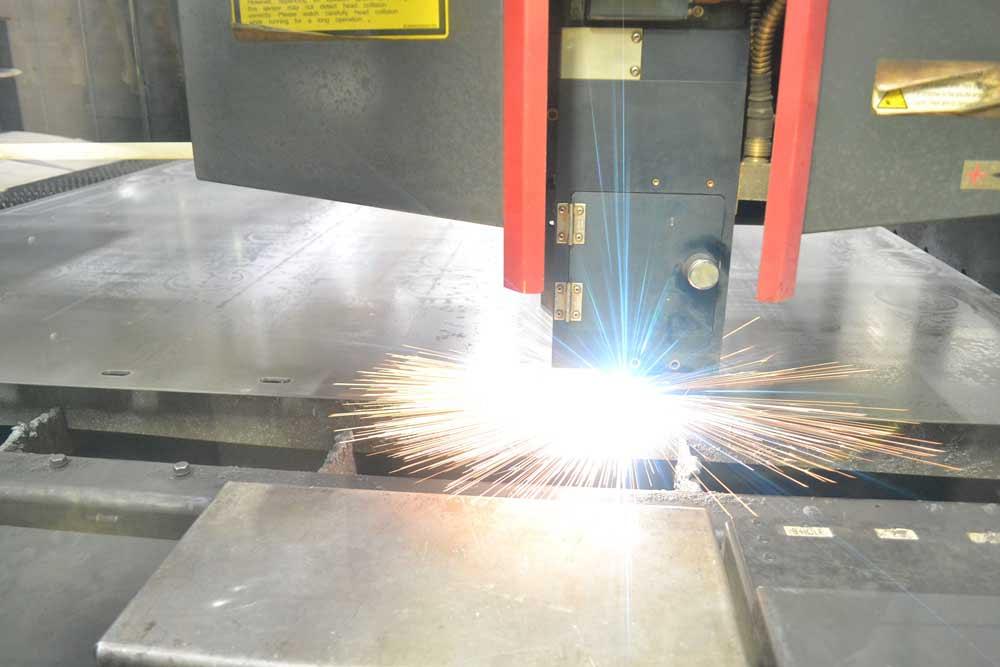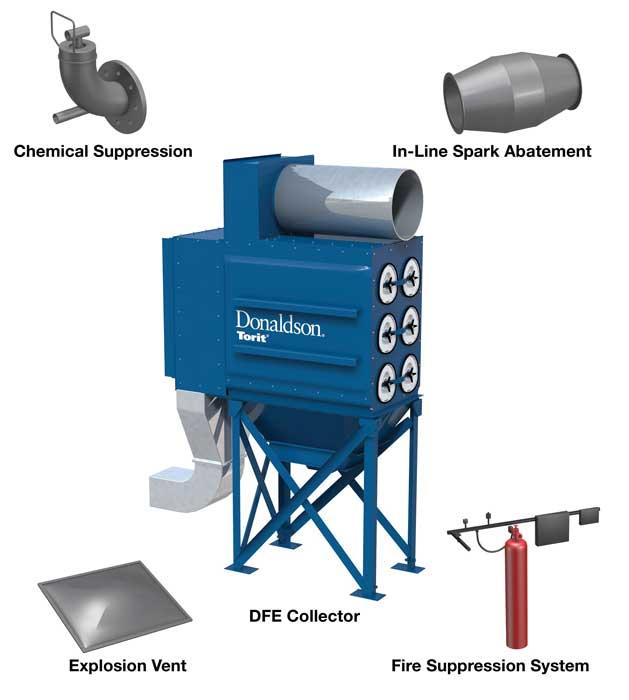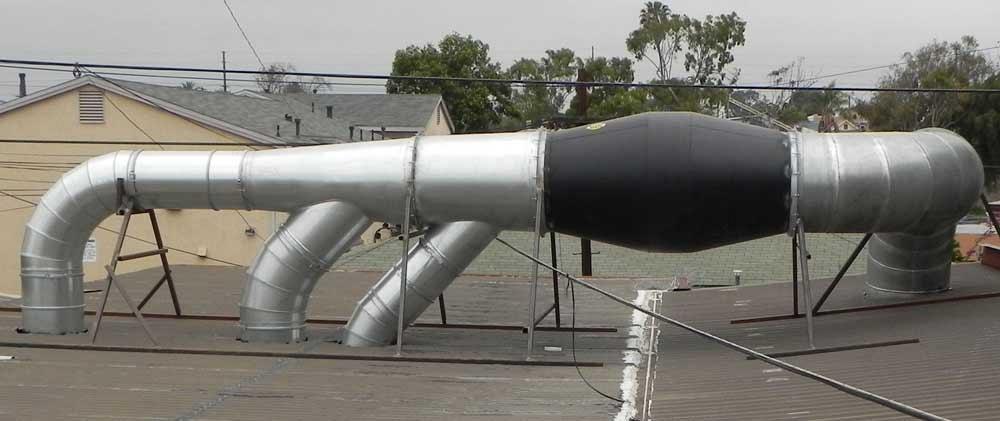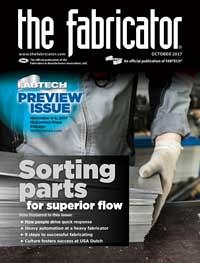Market Manager
- FMA
- The Fabricator
- FABTECH
- Canadian Metalworking
Categories
- Additive Manufacturing
- Aluminum Welding
- Arc Welding
- Assembly and Joining
- Automation and Robotics
- Bending and Forming
- Consumables
- Cutting and Weld Prep
- Electric Vehicles
- En Español
- Finishing
- Hydroforming
- Laser Cutting
- Laser Welding
- Machining
- Manufacturing Software
- Materials Handling
- Metals/Materials
- Oxyfuel Cutting
- Plasma Cutting
- Power Tools
- Punching and Other Holemaking
- Roll Forming
- Safety
- Sawing
- Shearing
- Shop Management
- Testing and Measuring
- Tube and Pipe Fabrication
- Tube and Pipe Production
- Waterjet Cutting
Industry Directory
Webcasts
Podcasts
FAB 40
Advertise
Subscribe
Account Login
Search
Actions and reactions: Combustion dangers in metal manufacturing
Know your hazards and plan for a fire or explosion
- By Karen Wear
- October 18, 2017
- Article
- Safety

Figure 1
Laser cutting produces fine metal particles that are gathered into dust collectors. Fabricators should realize that a mixture of metal and metal oxide particles from such an operation can result in a combustible event. That’s why they should be aware of the prevention and protection steps that can keep employees and the facility safe. All images courtesy of Donaldson Co. Inc.
New technologies such as fiber laser cutting machines and flexible manufacturing cells that can produce parts without operator intervention are providing metal fabricators with new capacity and opportunities to expand their businesses.
This potential growth surge is good news for shops, but has a potential downside as well: It also could increase combustion risks in your facility. As you expand the range of materials you’re processing, run longer hours, or lease time on your equipment to other companies, you may be exposing the shop to new combustion hazards from metals or metal combinations that you didn’t have to consider previously.
Most metal processing facility owners should recognize their processes have an inherent probability for a combustion event because of sparks produced during normal welding, cutting, and grinding activities. The addition of new materials, operations, and production shifts increases the potential for a combustion event and adds challenges to mitigation strategies. The reality is that metal fires burn with extraordinary heat and are more complicated to extinguish. With that in mind, shop owners and management should make preventing a fire a high priority.
Managing these new combustion risks can be a tough assignment if you’re a facility owner or supervisor already being pulled in many directions. The job becomes clearer if you approach it in logical steps:
- Review your processes and the dusts produced.
- Determine and understand the applicable industry and regulatory standards.
- Consider the variety of combustible dust mitigation equipment options. It is also important to engage the right experts in hazard analysis and risk mitigation.
Know Your Metals
It’s essential to understand the properties of the metals you currently process, as well as metals you could potentially handle. In general, all combustible dusts are more volatile as they become fines or smaller particulates. The heat in metal cutting and welding processes produces very small metal and metal oxide particles classified as fumes rather than dusts. These fumes (1 micron or less in size) create challenging combustion properties, so testing dusts or fumes to determine their combustion risks is an essential first step. Make certain to consider all the processes, as each area may produce a unique dust or fume.
Also, it is important to understand where dusts and fumes may be mixed or mingled. In some instances, the mixture will present different risks than either material alone.
It’s important to determine how your metals behave in your process environment when exposed to oxygen (oxidized); when mixed with other metals or metal oxides; and when in contact with common fire-extinguishing agents such as water, carbon dioxide, or argon.
Mild steel and aluminum stock are stable materials and generally straightforward to work with in process equipment as compared with exotic metals such as titanium, magnesium, and manganese. But even mild steel becomes explosive when finely divided by cutting, welding, or grinding. Despite popular belief, operations such as welding, laser cutting (see Figure 1), and plasma cutting do not fully oxidize the base metal involved. These operations instead produce a mixture of very fine fumes of both metal and metal oxide particles, which can have potential combustion risks.
Consider iron oxide and aluminum particles, which when mixed have the potential for a thermite reaction, defined as an “exothermic reaction between a metal and any metal oxide lower in the electromotive series,” according to National Fire Protection Association (NFPA) standard 484. Like any thermite reaction, an aluminum and iron oxide reaction is challenging to manage. The reaction requires no additional oxygen, making it difficult to extinguish. It needs no external source to ignite, making it very difficult to prevent. And it produces very high temperatures (4,000+ degrees F) with lots of molten iron, making it potentially destructive to workers, equipment, and facilities.

Figure 2
The dust collector is at the heart of any combustible dust management system. Other mitigation options are available to more fully prevent fires and explosions and protect workers if something were to happen.
Many metals also react with typical firefighting techniques, such as the use of water, and require special mitigation handling. Some metals, including aluminum, magnesium, and titanium, can split water molecules into hydrogen and oxygen gases with associated combustion risks. In addition, adding water to high-temperature metal fires potentially creates steam explosions with devastating effects.
These are just a few examples of the properties and potential reactions to understand when working with metals. Risks with metals can vary dramatically and are often unpredictable. Given the range of materials today’s manufacturing equipment can process, you should have all your shop’s dust and fumes lab-tested for combustibility. Also be sure the dust and fume you test is representative of the conditions in your operations. Seemingly stable metals can mix with other metals or oxidize and change composition from the original point.
Combustible Metal Standards
A metal fabrication facility is likely to be subject to a number of standards, and the next step is to review which standards apply to your applications.
The NFPA has multiple standards, including general guidelines for combustible dusts. Both NFPA 652, Standard on the Fundamentals of Combustible Dust, and NFPA 654, Standard for the Prevention of Fire and Dust Explosions from the Manufacturing, Processing, and Handling of Combustible Particulate Solids, are referenced by all industries. But the metals industry is also covered by NFPA 484, Standard for Combustible Metals, which goes into additional requirements for facilities handling and processing metal.
A growing number of local governments are adopting NFPA standards, making them legal requirements. Other “authorities having jurisdiction,” including fire marshals, OSHA inspectors, loss prevention engineers, and underwriters, cite NFPA standards when they levy fines, deny permits, or withhold policy coverage.
Consult the specific chapters in NFPA 484 for the metals you handle for information on methods of housekeeping, fugitive dust handling, storage, combustion prevention and protection equipment, and firefighting activities.
NFPA standards are especially cautious about metal reactivity. NFPA 484 restricts the collection of incompatible materials and often recommends dedicated workcells, ducting, and dust collectors for specific metals being processed. Label these zones clearly, and educate employees about the dangers of processing multiple materials on the same equipment.
Also detailed in NFPA 484 are the recommended safe and effective extinguishing agents for a variety of metals. NFPA 484, Table A.6.3.3, Combustible Metal Fire-Extinguishing Agents Quick Reference Chart is a great resource. In aluminum fires, for example, argon is the preferred extinguishing agent instead of water or carbon dioxide.
Prevention and Protection: Mitigation Options
A dust or process hazard analysis (DHA or PHA) of your facility helps to determine where risks are present and ways to minimize those risks. Start by analyzing all of your processes and determining where dust or fumes are produced. Next, understand which processes may generate sparks or have other hazards, such as hot surfaces. Finally, check to see if any mitigation equipment is already in place and whether it is working properly.
Once you complete this review, you can consider strategies to reduce risks associated with a possible combustion event (see Figure 2). Your strategies should encompass both prevention—reducing the likelihood of an event—and protection—limiting the overall impact or damage when an event does occur. As an example, one prevention strategy is keeping ignition sources away from accumulated dust and fumes in the collector. When it comes to protection, one strategy is placing a collector outside to reduce the risk of a fire damaging nearby equipment or harming nearby workers (see Figure 3).

Figure 3
National Fire Protection Association standards recommend an outdoor location for dust collectors.
The following are some mitigation options to consider for your metal processing facility.
Housekeeping. Use suitable housekeeping methods at appropriate frequencies to keep your facility clean and prevent the buildup of nuisance dust that would represent potential fuel for a catastrophic secondary event. This includes ensuring dust and fumes are controlled and transported properly to a collection source. Have a maintenance schedule that targets both visible and out-of-sight areas for potential dust buildup.Minimizing the amount of fuel accumulation (dust) in a dust collector also can help to limit the impact if an event occurs in the collector. NFPA 484 requires daily removal of dust from the dust collector, or more frequently if the application requires it.
Dedicated Equipment. As previously discussed, NFPA 484 raises concerns about reactive metals and recommends the use of dedicated equipment to keep metals separate. Dust collection manufacturers are helping process owners address their need for dedicated point-of-use dust collectors with new filtration technology that has a smaller footprint. Fabricators also should add labeling to dedicated units and train employees on the appropriate use of that equipment.
Spark Control. Focus on keeping ignition sources (sparks) away from the accumulated dust and fumes (fuel) in the dust collector. In metals processing, the typical spark control method is passive spark mitigation (see Figure 4). A passive spark arrester mounted in the duct may create turbulence to accelerate the rate at which sparks extinguish in the airstream. Active spark mitigation systems that detect and douse sparks with water may not be suitable for some combustible metal applications.
Another ignition source mitigation method is to spread out components in your system, so sparks have to travel longer distances, allowing time for them to die out before reaching the fuel in the collector. Locating a dust collector outdoors, which is typical for metal applications, may allow distances necessary for sparks to extinguish. Keep in mind that velocity within a typical duct is relatively high (4,500 feet per minute), so a distance strategy may require significant duct lengths to allow a few seconds for a spark to extinguish.
Even with prevention options in place, a prudent shop owner will plan protection measures to limit potential harm to workers and damage should a combustible event occur. Following are some options.
Equipment Location. Outdoors is the recommended location for dust collectors in NFPA standards. An outdoor location may offer additional mitigation strategies. In some cases, a cost-benefit analysis may support letting a fire burn itself out if it can be safely isolated. In other instances, the investment in a fire mitigation system may be a more suitable strategy.
Fire-extinguishing Systems. A variety of methods can be used to extinguish a fire. To determine the most suitable method for your facility, you will need to know the types of combustible dusts present.
A water-based sprinkler system may be a low-cost option to extinguish fires, but it can require significant cleanup and downtime following an event. Additionally, water-based systems may not be effective or feasible for all types of metals.

Figure 4
A typical spark control method is passive spark mitigation, which is used in the dust management system at the Workshops for Warriors training center in San Diego.
Carbon dioxide- and argon-based extinguishing systems are another option. They typically have higher initial costs, but faster recovery times may make them more attractive for some facilities. Again, though, they may not be suitable for all types of metals.
Explosion Venting. These passive devices consist of specialized panels positioned on the dust collector. A panel is designed to open during the early stages of a deflagration to avoid the buildup of destructive pressure levels within the collector. The panel opening allows combustion gases, flames, and burning debris to vent from the collector rapidly. The panel should be positioned to direct all vented materials to a safe area or exclusion zone where employees are not located during normal operation. Equipment controls should be located outside the exclusion zone. It is worth noting that in a properly vented explosion, a fire risk may still exist.
Explosion Suppression. A rapid pressure rise in the collector triggers injection of a chemical suppressant (typically sodium bicarbonate) to halt combustion before damaging pressures develop in the protected equipment. This device has comparatively higher initial costs, but is highly effective and reduces the risk of a subsequent fire as well.
Isolation. One key strategy to limiting the consequences of a deflagration is to ensure the damage remains limited to the initial process where a deflagration occurs. An isolation device must close a duct well in advance of any flames traveling from a deflagration event. This means there may be physical limits on where devices can be located, and combustion behavior of metals makes selection and installation strategies more difficult as the speed of the flame increases.
Knowing combustion properties for dusts is very beneficial in selecting appropriate isolation devices. Passive isolation devices utilize the pressure wave from a deflagration to mechanically close the device. Active isolation devices use an electronic sensor to detect a deflagration event and activate the closure of the device. Both styles of isolation have performance limits when dealing with the higher Kst (speed of pressure rise) values associated with metals, so discuss your selection carefully with the manufacturer of your isolation equipment.
Mitigation decisions should not be made while a combustion event is in progress. That’s why a good review and plan are needed to prevent mistakes from occurring. This allows you to ensure employees know the proper emergency procedures concerning the metal dusts. Also, a plan allows you the opportunity to alert city authorities to the metals in your facility and mitigation equipment in place so crews are prepared to respond appropriately to an emergency call.
About the Author
subscribe now

The Fabricator is North America's leading magazine for the metal forming and fabricating industry. The magazine delivers the news, technical articles, and case histories that enable fabricators to do their jobs more efficiently. The Fabricator has served the industry since 1970.
start your free subscription- Stay connected from anywhere

Easily access valuable industry resources now with full access to the digital edition of The Fabricator.

Easily access valuable industry resources now with full access to the digital edition of The Welder.

Easily access valuable industry resources now with full access to the digital edition of The Tube and Pipe Journal.
- Podcasting
- Podcast:
- The Fabricator Podcast
- Published:
- 04/16/2024
- Running Time:
- 63:29
In this episode of The Fabricator Podcast, Caleb Chamberlain, co-founder and CEO of OSH Cut, discusses his company’s...
- Trending Articles
Capturing, recording equipment inspection data for FMEA

Tips for creating sheet metal tubes with perforations

Are two heads better than one in fiber laser cutting?

Supporting the metal fabricating industry through FMA

Omco Solar opens second Alabama manufacturing facility

- Industry Events
16th Annual Safety Conference
- April 30 - May 1, 2024
- Elgin,
Pipe and Tube Conference
- May 21 - 22, 2024
- Omaha, NE
World-Class Roll Forming Workshop
- June 5 - 6, 2024
- Louisville, KY
Advanced Laser Application Workshop
- June 25 - 27, 2024
- Novi, MI


























